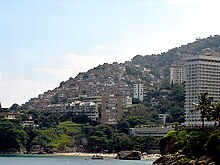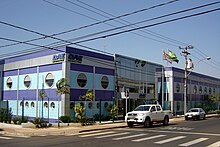Water supply and sanitation in Brazil
A high number of poor Brazilians live in urban slums (favela) and in rural areas without access to piped water or sanitation.
Brazil has a low share of collected wastewater that is being treated (35% in 2000), and long-standing tensions between the federal, state and municipal governments about their respective roles in the sector.
While Brazil has pioneered the use of low cost appropriate technology (such as condominial sewers) and active community participation it still faces the challenge of the many informal peri-urban settlements, called favelas, often situated on steep slopes or in flood plains.
An example of how the government addresses these issues is the World Bank-supported Low Income Sanitation Technical Assistance Project PROSANEAR.
Until 1985, only these public companies could obtain financing from BNH for water supply and sanitation, being responsible for construction, operation and maintenance.
The favorable performance of the economy, the scale of the system being installed, the amount of funds available and the subsidized interest rates on loans, all helped services to expand quickly.
For example, Lemos and Oiveira labeled the state water and sanitation companies as "pre-democratic institutions" that perceived themselves as "islands of competence", constituting an "infallible technocracy" which systemically warded off public involvement in policy-making.
[14] PLANASA also reduced the role of many municipal governments to signing concession contracts with state water companies, leaving them with a sense of marginalization.
Water and sanitation policy thus entered a new era that was characterized by an environment of increasing legal uncertainty and political controversy.
In the same year his government created a Ministry of Cities with a National Department of Environmental Sanitation, entrusted with the responsibility to monitor sector performance and to establish directives for "basic sanitation" (including water supply, sewerage, wastewater treatment and solid waste management, which are all covered by the Portuguese term saneamento básico).
The law aims at increasing investments to provide universal access to water and sanitation, while taking into account local specificities and using appropriate technologies that are in line with users' ability to pay.
Nevertheless, the law fills a void by providing a legal basis for the role of the federal government in water and sanitation that had remained undefined during the previous 20 years.
[16] Léo Heller, professor of sanitary and environmental engineering at the Federal University of Minas Gerais, even called it "arguably the most important legislative innovation in basic sanitation sector in decades".
[8] In the same month, the President announced a new Program for the Acceleration of Growth (PAC) that includes major investments in highways, airports, ports, energy, as well as providing housing, water and sewage that would benefit poor Brazilians.
[19] Approximately 9 million households (12.6%) had a ditch, rudimentary cesspit, river, lake or sea, in addition to other forms of waste disposal.
The Council of Cities is "a consultative and decision-making body with the purpose of 'proposing goals for the formulation and implementation of national urban development policy, as well as monitoring and assessing its execution".
Nevertheless, 14 Brazilian states have established regulatory agencies for public services that cover, among other sectors, water supply and sanitation.
According to the Brazilian constitution the provision of water and sanitation services is the responsibility of the country's 5,560 municipalities (see List of major cities in Brazil).
According to a 2005 study by the Latin American association of water and sanitation regulators ADERASA the typical monthly residential water bill for a consumption of 20 cubic meters per month was equivalent to US$17 in São Paulo, US$15 in Espírito Santo and US$10 in Pernambuco, compared to an average of US$11 among the 21 Latin American cities covered.
[citation needed] However, some State Water Companies have improved the targeting of their social tariffs by using the cadastres established for the Bolsa Familia Conditional Cash Transfer program.
[35] It has been estimated that investments in water and sanitation infrastructure in the order of R$9.6 billion (US$4.5bn or $24 per capita or 0.7% of GDP) per year, or almost three times the level of 2005, would be needed to achieve universal access.
Loans to state governments from international financial institutions, such as the World Bank and the IDB, are also passed on to utilities as a non-reimbursable contribution to their capital.
In January 2007, the federal government announced a new Program for the Acceleration of Growth (PAC) that includes major investments in highways, airports, ports, energy, as well as providing housing, water and sewage that would benefit poor Brazilians.
Approved on December 6, 2000, the US$130 million loan aims to improve potable water and sewerage services, institutional efficiency, financial sustainability, private sector participation in management and investment financing for the Federal District of Brasília.
Approved on October 20, 1999, the US$200 million loan aims to improve the environmental quality of the Tiete River basin in the Sai Paulo Metropolitan Region.
Approved on September 6, 2005, the US$46.8 million loan aims to assist the State of Minas Gerais to reduce high levels of poverty through several aspects, including, improvement of sewerage infrastructure (20%).
Approved July 12, 2005, the US$649 million loan aims to strengthen social inclusion in the State of Ceará through 24% of expenditures in water, sanitation, and flood protection.
Approved on December 7, 2004, the US$6.81 million loan aims to reduce urban and rural poverty through 25% expenditures in the water, sanitation, and flood protection sector.
Approved on April 24, 2003, the US$84 million loan seeks to enhance urbanization by improving water supply (30%) and solid waste management (30%).
Germany supports water supply and sanitation projects in small and medium towns of the mostly poor and arid North-East of Brazil, as well as in the metropolitan area of Belo Horizonte.




